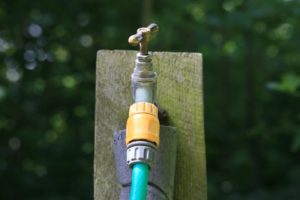Advantages & Disadvantages of Drip Irrigation
May 10, 2018 Deep, penetrating watering is the best way to ensure your landscape survives the stresses of the warm season. Proper watering technique calls for watering less frequently, but more at one time, to give your garden a quality soaking that gives roots a sufficient supply of water. This is better than the quick surface watering you see by less experienced gardeners.
Deep, penetrating watering is the best way to ensure your landscape survives the stresses of the warm season. Proper watering technique calls for watering less frequently, but more at one time, to give your garden a quality soaking that gives roots a sufficient supply of water. This is better than the quick surface watering you see by less experienced gardeners.
For commercial landscapes, as well as larger residential landscapes, a drip irrigation system can be an effective alternative to hiring a landscaping crew or doing the task yourself.
Drip irrigation is a more controlled watering method than using a surface sprinkler or a hose. It uses plastic tubes that distribute water along the length of the system through small holes. These holes connect to emitters that are set near your plants and allow for watering at a slow and very thorough rate.
If you’re considering adding a drip irrigation system to your landscape, check out this list of advantages and disadvantages that are worth considering before investing in this type of watering method.
Advantages
- Saves water – Improving the efficiency of watering helps you use less water throughout the life of your drip irrigation system. This can add up to significant savings over time.
- Easy to install – Even for those who aren’t mechanically inclined, drip irrigation is very easy to install. It’s as simple as laying the tubing and connecting the few remaining pieces. Also, it’s portable and adaptable, so if you modify the layout of your plants you can also modify your drip irrigation system.
- Improves plant health – When water is delivered directly to the base of the plant, you don’t have to worry about drift (wind carrying water away), soil erosion, or wet leaves which can lead to problems like mold and disease.
- Saves time – Once you program your irrigation timer, you no longer need to worry about dragging out the hose or watering multiple times on hot days.
Disadvantages
- Installationtime – Depending how large your planting area is, it can take a large amount of time to set up all the tubes, lines, filters, and timers. As you add to or change the landscape over time, you’ll need to adjust the system to ensure everything is being covered.
- Not suitable for lawns – These types of watering systems are primarily used in planting beds. They aren’t ideal for lawns.
- Ongoing maintenance – In order to make sure your drip irrigation system is running efficiently, you’ll need to see that the emitters and tubes are clog-free and the lines aren’t chewed through. If your system uses filters, these will need to be cleaned or changed regularly. You’ll also need to perform regular system flushes to keep the system free and clear.
- Oversight – If you aren’t meticulous in your system maintenance, you may start to notice portions of your landscape are starting to show signs of distress. If parts of your system start to clog, leak, or are otherwise damaged, your plants will decline rapidly due to lack of water.
We hope you find this article helpful when considering a drip irrigation system for your residential or commercial landscape property. Of course, if you need help installing or maintaining your landscape, give Hively a call at 717-292-5696 and we’ll be happy to help.